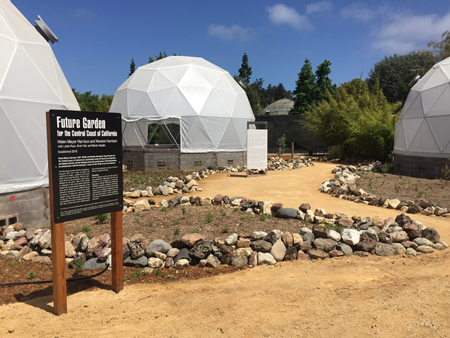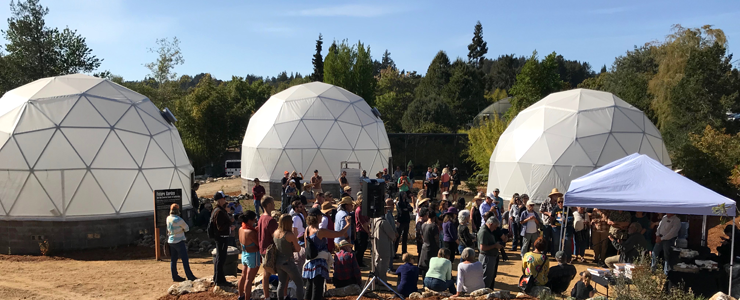The Future Garden
The Future Garden
Beyond our succulent garden and below the Horticulture buildings, you'll come to the Future Garden, a major art and science project by Newton Harrison and his late wife and lifelong collaborator Helen Mayer Harrison.

Listen to the artists and others talk about Future Garden for KQED.
Internationally renowned eco-artists and UC Santa Cruz emeritus faculty, the Harrisons created a site-specific environmental art installation in the three geodesic domes and the surrounding garden at the Arboretum. Called Future Garden for the Central Coast of California, the installation, which Newton Harrison continues to evolve, transforms the newly refurbished domes at the Arboretum from relics of the past, steeped in 1970s era charm, into carriers of the future in response to the crisis of climate change.
The Harrisons worked with scientists at UC Santa Cruz and botanists at the Arboretum, along with other artists, scientists, and visionaries, to create trial gardens within the domes in which native plant species are subjected to the temperatures and water conditions that scientists see for the region in the near future. The aim is to determine which plants are best able to thrive as the region warms and to propagate these species to create the scaffolding for more rapid regeneration of the local ecosystem as climates shift. As the Harrisons explained, the future for the rapidly warming planet lies in finding durable plant species that together create ecosystems that can continue to live and flourish as temperature increases.

The geodesic domes of the Arboretum provide the perfect setting for imagining a future in the face of climate change. With their new gleaming white coverings, the domes seem to have arrived here from outer space—or at least from a science fiction novel—to bring warnings about the perils of inaction as the world warms. Not just bearers of bad tiding, the fantastical domes are models for how, as Newton Harrison says, “people can take responsibility for a deeply stressed planet.”
Future Garden is sponsored by the Nion McEvoy Family Trust of the San Francisco Community Foundation, the Metabolic Studio, 30 Petals Fund, Rowland and Pat Rebele, and annual donors to the Institute of the Arts and Sciences.
Artist Statement: Every Place is the Story of its Own Becoming
About the Artists:
Helen Mayer Harrison and Newton Harrison have collaborated as an art making team since the late 1960s, working with biologists, ecologists, architects, urban planners and other artists to propose sustainable solutions to ecological challenges and the crisis posed by climate change. Their projects have been shown in major exhibitions, museums, art festivals, and galleries around the world. Prestel Press published The Time of the Force Majeure, surveying the Harrisons' forty-five year career in ecological art in 2016.
In 2010, the artists founded the Center for the Study of the Force Majeure at UC Santa Cruz to pursue strategies that blend art and science to respond creatively and at vast scale to global warming and climate change. The Center for the Study of the Force Majeure brings together artists and scientists to design ecosystem-adaptation projects in critical regions around the world to respond to climate change.

About the Institute of the Arts and Sciences is an interdisciplinary exhibition and event forum in the Arts Division of the University of California, Santa Cruz. The IAS's mission is to harness the creative power of the arts and the sciences to explore big questions and critical issues of our time. It contributes to the cultural life of UC Santa Cruz and features the work of nationally renowned artists and groundbreaking scientists and scholars. The IAS offers a range of public programs, sponsors residencies, and curates and organizes an ambitious exhibition program.

